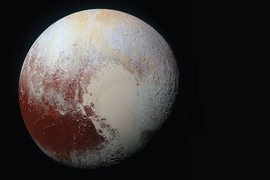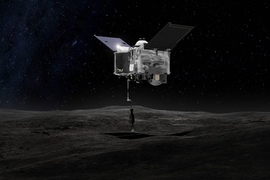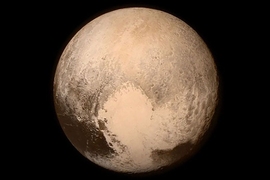Beneath Pluto’s “heart” lies a cold, slushy ocean of water ice, according to data from NASA’s New Horizons mission. In a paper published today in the journal Nature, the New Horizons team, including researchers from MIT, reports that the dwarf planet’s most prominent surface feature — a heart-shaped region named Tombaugh Regio — may harbor a bulging, viscous, liquid ocean just below its surface.
The existence of a subsurface ocean may solve a longstanding puzzle: For decades, astronomers have observed that Tombaugh Regio, which is Pluto’s brightest region, aligns almost exactly opposite from the dwarf planet’s moon, Charon, in a locked orientation that has lacked a convincing explanation.
A thick, heavy ocean, the new data suggest, may have served as a “gravitational anomaly,” or weight, which would factor heavily in Pluto and Charon’s gravitational tug-of-war. Over millions of years, the planet would have spun around, aligning its subsurface ocean and the heart-shaped region above it, almost exactly opposite along the line connecting Pluto and Charon.
“Pluto is hard to fathom on so many different levels,” says New Horizons co-investigator Richard Binzel, professor of earth, atmospheric and planetary sciences at MIT. Binzel is also a joint professor of aerospace engineering and a faculty affiliate with the MIT Kavli Institute. “People had considered whether you could get a subsurface layer of water somewhere on Pluto. What’s surprising is that we would have any information from a flyby that would give a compelling argument as to why there might be a subsurface ocean there. Pluto just continues to surprise us.”
Features from a flyby
On Jan. 19, 2006, New Horizons, a spacecraft about the size of a baby grand piano, launched from Cape Canaveral, Florida, on a nine-year journey to the solar system’s distant dwarf planet. On July 14, 2015, the probe approached Pluto and spent the next three months observing its surface before completing the flyby and continuing on to the Kuiper belt.
During its flyby of Pluto, New Horizons collected measurements of surface features, including the dimensions of Pluto’s bright, heart-shaped region. In particular, the spacecraft focused on a circular region in its left “ventricle,” named Sputnik Planitia, which is thought to be a giant impact basin. From the probe’s measurements, Binzel and his colleagues determined the size and depth of Sputnik Planitia.
“It’s similar in proportional size to the largest basins on Mercury and Mars,” Binzel says.
The researchers determined that the heart-shaped region, and Sputnik Planitia in particular, is aligned almost exactly opposite from Charon.
“The New Horizons data say it’s not only opposite Charon, but it’s really close to being almost exactly opposite,” Binzel says. “So we asked, what’s the chance of that randomly happening? And it’s less than 5 percent that it would be so perfectly opposite. And then the question becomes, what was it that caused this alignment?”
A viscous ocean
The massive basin also appears extremely bright relative to the rest of the planet, and the reason, the New Horizons data suggest, is that it is filled with frozen nitrogen ice.
Previously, Binzel and the New Horizons team had found evidence that this liquid nitrogen may be constantly refreshing, or convecting, as a result of a weak spot at the bottom of the basin. This weak spot may let heat rise through Pluto’s interior to continuously convect the ice, bubbling it over “like boiling oatmeal,” Binzel says.
To the New Horizons team, a weak spot in Sputnik Planitia’s basin suggests that the planet’s crust, particularly in this region, must be quite thin. If a massive impactor indeed created the basin, it may have also triggered any material beneath the surface to push the thin crust outward, causing a “positive gravitational anomaly,” or a thick, heavy mass, that would have helped to align the region relative to Charon.
But what sort of material would create enough of a gravitational weight to reorient the planet relative to its moon? To answer this, the team turned to a geophysical model of Pluto’s interior, working in measurements from the New Horizons spacecraft.
“Pluto is small enough that it’s just about almost cooled off but still has a little heat, and it’s about 2 percent the heat budget of the Earth, in terms of how much energy is coming out,” Binzel says. “So we calculated Pluto’s size with its interior heat flow, and found that underneath Sputnik Planitia, at those temperatures and pressures, you could have a zone of water-ice that could be at least viscous. It’s not a liquid, flowing ocean, but maybe slushy. And we found this explanation was the only way to put the puzzle together that seems to make any sense.”
Lindy Elkins-Tanton, director of the School of Earth and Space Exploration at Arizona State University, says the team’s results for Pluto may have implications for planetary bodies further out in the solar system.
“A few researchers have thought Pluto could retain enough heat to still be warm, but it’s been a minority opinion — most people thought Pluto must be cold by now! So an ocean is a very welcome and extremely interesting result,” says Elkins-Tanton, who did not contribute to the paper. “The surprises of Pluto raise the possibility that other Kuiper Belt objects may also still be warm. These results immediately put large Kuiper belt objects on the list of places that could harbor life. What a great surprise!”
An icy heart
In addition to being aligned with Charon, Pluto’s heart lies almost exactly at the equator — a location which Binzel’s graduate student and co-author Alissa Earle has found may have helped the region keep its alignment with Charon locked firmly in place.
In a separate paper that was published online in September in the journal Icarus, Earle modeled Pluto’s surface temperatures over millions of years and found that while the poles experience wild swings in temperature, with long frigid winters and equally long, hot summers, the equator has more moderate temperatures. That’s because it cycles through daytime and nighttime fairly regularly, every three days.
Earle found that if bright ice builds up at the poles, it simply melts away when summer returns. But if that same ice forms near the equator, it never gets warm enough to melt away.
“What makes the equator unique is, if you put a bright spot there, because it never gets too hot or cold, then the bright spot will always stay cold,” Earle says. “If ice accumulates at the equator, it can hang onto it.”
Earle modeled the region’s temperatures over millions of years, looking at the tilt of Pluto’s axis, its orientation to the sun, and its daily rotation. From all this, she found that Sputnik Planitia’s ice sheet likely has persisted for millions of years. The long-lived deposit of ice on Pluto’s “heart” may have also played a role in orienting the planet toward its moon.
“This basin probably has been there a long time and had this bright ice spot for a very long time,” Earl says. “And that may have helped to get it rotated to where it is today.”
This research was funded, in part, by NASA.











